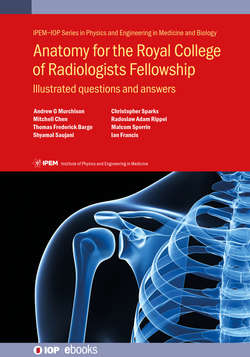Читать книгу Anatomy for the Royal College of Radiologists Fellowship - Malcolm Sperrin - Страница 21
На сайте Литреса книга снята с продажи.
Q1.13 Coronal section from an MRI study of the orbits
Оглавление1 Name the arrowed structure.
2 Name the arrowed structure.
3 Name the arrowed structure.
4 Name the arrowed structure.
5 Name the arrowed structure.
Answers
1 Left temporalis muscle.
2 Left lateral rectus muscle.
3 Right optic nerve.
4 Right superior oblique muscle.
5 Right superior frontal gyrus.
Comments:
The four rectus muscles—superior and inferior, lateral and medial, are well demonstrated on a coronal MRI, and the lateral and medial rectus muscles are also common questions on axial imaging. The lateral rectus muscle is innervated by the abducens nerve (6th cranial nerve), whilst the other rectus muscles are innervated by the oculomotor nerve (3rd cranial nerve).
The superior oblique muscle originates from the medial side of the orbit, superior to the medial rectus. It is innervated by the trochlear nerve (4th cranial nerve). The inferior oblique is a small muscle which, unlike the other extra-ocular muscles, does not have its origin at the orbital apex but instead originates from the maxillary bone in the anterior orbit. Like three of the rectus muscles, it is innervated by the oculomotor nerve.
In the eye itself, the lens and the vitreous humour behind it are readily demonstrable on CT or MRI.
The optic nerve travels posteriorly through the orbit from the retina. It travels through the optic canal into the suprasellar cistern, where it meets the contralateral nerve at the optic chiasm.
Exam tip:
The lacrimal gland can sometimes crop up as a sneaky question on axial or coronal sequences, and is found at the superolateral aspect of the orbit.
